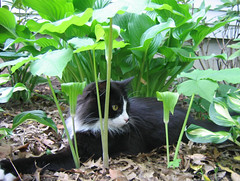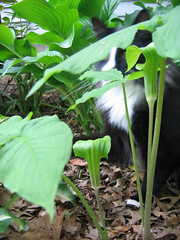Moon Jack
I once worked with a botanist who was a bit of an odd duck. Once, after taking her seat on an airplane, her fellow passenger asked her what she did for a living.
“I’m a botanist,” she answered.
“Oh? What sort of botany?” asked her companion.
“Lunar botany.”
With that, her seatmate was suitably impressed and satisfied.
I felt a bit like a lunar botanist myself upon moving to Cincinnati. I was trained in Pacific Northwest flora, with Western Washington and the Sierra Nevadas as my primary stomping grounds. Although a few of the species here are familiar, most of them might as well be from another planet. One of the most alien plants is the jack-in-the-pulpit, Arisaema.
I first encountered Jack in Tim’s wildflower garden and was utterly charmed, despite its odd appearance. The leaves are very similar to trillium, but the flower is quite different. It looks a little like a green calla lily, except that the top edge of the spathe flips horizontally at its tip to provide a canopy for Jack (the spadix). I could resist flipping the pulpit flap up repeatedly to peek at Jack tucked away inside. Tim earned my eternal gratitude by allowing me to dig a few for my own garden.
 I planted my Jacks in my shade garden and they promptly withered away. I was horrified. Little did I know that he often goes dormant in midsummer. This spring, what I took to be oddly purplish hosta spikes were actually my Arisaema returning. They surprised me by growing far larger than last year. In fact, jack-in-the-pulpit can grow to be three feet tall.
I planted my Jacks in my shade garden and they promptly withered away. I was horrified. Little did I know that he often goes dormant in midsummer. This spring, what I took to be oddly purplish hosta spikes were actually my Arisaema returning. They surprised me by growing far larger than last year. In fact, jack-in-the-pulpit can grow to be three feet tall.
Jack not only looks alien, but he has some odd reproductive behavior as well. Young plants are male, while more mature plants often become female (Jills). Fertilized female flowers develop appetizingly crimson (but poisonous) fruits. If conditions are poor, Jill will become a Jack again.
This has turned out to be an easy care groundcover for shady areas. I transplanted more Jacks in April and, with supplemental water, I had no dieback. I plan on raiding Tim’s yard for some more (with his permission, of course), because I’ve learned that he has purple-striped varieties as well. Fancy Jack!
 These alien eastern plants are starting to grow on me. I really have no need to go the moon to find weird and exotic species. I’m still not wholly convinced, though, that Jack-in-the-pulpit wasn’t snuck onto our planet like Audrey II. As long as he doesn’t eat my cat, I guess it’s safe.
These alien eastern plants are starting to grow on me. I really have no need to go the moon to find weird and exotic species. I’m still not wholly convinced, though, that Jack-in-the-pulpit wasn’t snuck onto our planet like Audrey II. As long as he doesn’t eat my cat, I guess it’s safe.
“I’m a botanist,” she answered.
“Oh? What sort of botany?” asked her companion.
“Lunar botany.”
With that, her seatmate was suitably impressed and satisfied.
I felt a bit like a lunar botanist myself upon moving to Cincinnati. I was trained in Pacific Northwest flora, with Western Washington and the Sierra Nevadas as my primary stomping grounds. Although a few of the species here are familiar, most of them might as well be from another planet. One of the most alien plants is the jack-in-the-pulpit, Arisaema.
I first encountered Jack in Tim’s wildflower garden and was utterly charmed, despite its odd appearance. The leaves are very similar to trillium, but the flower is quite different. It looks a little like a green calla lily, except that the top edge of the spathe flips horizontally at its tip to provide a canopy for Jack (the spadix). I could resist flipping the pulpit flap up repeatedly to peek at Jack tucked away inside. Tim earned my eternal gratitude by allowing me to dig a few for my own garden.
 I planted my Jacks in my shade garden and they promptly withered away. I was horrified. Little did I know that he often goes dormant in midsummer. This spring, what I took to be oddly purplish hosta spikes were actually my Arisaema returning. They surprised me by growing far larger than last year. In fact, jack-in-the-pulpit can grow to be three feet tall.
I planted my Jacks in my shade garden and they promptly withered away. I was horrified. Little did I know that he often goes dormant in midsummer. This spring, what I took to be oddly purplish hosta spikes were actually my Arisaema returning. They surprised me by growing far larger than last year. In fact, jack-in-the-pulpit can grow to be three feet tall.Jack not only looks alien, but he has some odd reproductive behavior as well. Young plants are male, while more mature plants often become female (Jills). Fertilized female flowers develop appetizingly crimson (but poisonous) fruits. If conditions are poor, Jill will become a Jack again.
This has turned out to be an easy care groundcover for shady areas. I transplanted more Jacks in April and, with supplemental water, I had no dieback. I plan on raiding Tim’s yard for some more (with his permission, of course), because I’ve learned that he has purple-striped varieties as well. Fancy Jack!
 These alien eastern plants are starting to grow on me. I really have no need to go the moon to find weird and exotic species. I’m still not wholly convinced, though, that Jack-in-the-pulpit wasn’t snuck onto our planet like Audrey II. As long as he doesn’t eat my cat, I guess it’s safe.
These alien eastern plants are starting to grow on me. I really have no need to go the moon to find weird and exotic species. I’m still not wholly convinced, though, that Jack-in-the-pulpit wasn’t snuck onto our planet like Audrey II. As long as he doesn’t eat my cat, I guess it’s safe.


3 Comments:
Love the cat photos!
One day I'll get some Jacks, they are fun to watch, aren't they?
Can you grow them jacks in the UK?they seem fabulous plants.
I have had the worst luck with jacks. But I think I just have not gotten the soil up to snuff where I have planted them (repeatedly) I envy yours.
Post a Comment
<< Home